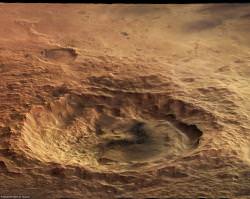Seen one Martian crater and you’ve seen them all right? Well, check this one out. It’s an image of Maunder Crater on the surface of Mars, captured by ESA’s Mars Express. Although the crater is large, 90 km (56 miles) across, it’s very shallow – less than a kilometre. It used to be much deeper, but some geologic process has since filled it in.
The images of Maunder crater were captured in late 2005 by Mars Express at a resolution of roughly 15 metres per pixel. The crater, named after British astronomer Edward W. Maunder, is located about halfway between Argyre Planitia and Hellas Planitia on the southern Highlands of Mars.
It once looked like a more traditional crater, but then something happened on the west side to make it cave in. A large landslide pushed material from the crater wall to the inner portion. The edges of the crater that remain show gullies that could have been created when large amounts of material was flowing down into the crater.
One intriguing discovery: there are gullies along the upper side of the trough in the middle of the crater that have been caused by seeping water.
Original Source: ESA News Release

